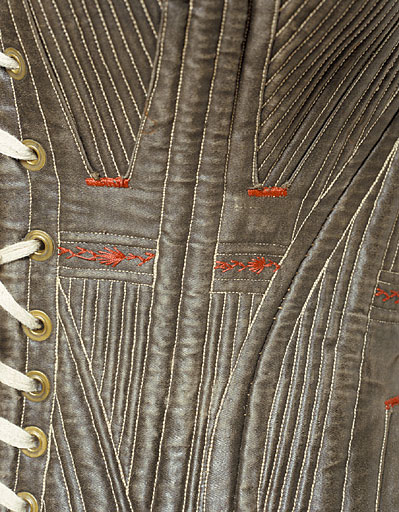corset
Summary
Black cotton satin lined with khaki twilled cotton. Fronts each in one piece, shaped to bust by two gussets, two vertical and two diagonal bones, remainder quilted, front edges boned and laced through thirteen metal eyelet holes, metal eyelet hole at top edge; very straight back in one piece, shaped to hip by two gussets each side, fourteen vertical bones, remainder quilted; top edge cut away at underarm, bound with petersham at front and brown leather at back, lower edge bound with navy blue tape; leather patch at centre back inside hem; decorative red stitching along outside waistline and at base of gusset.
Display Label
The corset as we know it today developed in the fourteenth century from the "cotte", a close-fitting woman's stiffened underbodice. From the fifteenth century, this became known as a "body" or pair of bodies, and by the seventeenth century the usual term was a pair of stays. These could be stiffened with cane or whalebone, creating a flattened front with the breast pushed upwards and not separated. The firm front of the stays could be covered with a decorated stomacher or else the stays themselves might be displayed. Stays were always worn over a linen shift or chemise, never next to the skin, and this protected them from inner dirt and minimised rubbing or chafing from the rigid edges. It was, of course, almost impossible to wash stays which were constructed from so many different materials. This striking pair of red stays from the Filmer Collection dates from the second quarter of the seventeenth century, and has a matching stomacher which could be laced in place. These are the earliest stays in the collections. The pale blue stays are from the 1770s and show the similar rigid formal shaping provided. The later brown pair are from about 1840 and have much more emphasis on the waist; by this date the French term corset was prevalent. The prints show a woman being laced into her stays around 1815, a male dandy about to be strapped into his stays, and a farmer's wife wearing stays over a skirt as she serves at table. Padded underbodices for children were still called "staybands" although they later became known as "liberty bodices".
Object Name
corset
Date Created
1840-1850
Dimensions
Length (back): 36cm
Length (front): 39cm
Waist: 62.5cm
accession number
1972.7
Collection Group
Medium
Legal
© Manchester Art Gallery

.1200x1200.jpg)
.1200x1200.jpg)
.1200x1200.jpg)
.1200x1200.jpg)
.1200x1200.jpg)
.1200x1200.jpg)
.1200x1200.jpg)
.1200x1200.jpg)
.1200x1200.jpg)
.1200x1200.jpg)
.1200x1200.jpg)
.1200x1200.jpg)
.1200x1200.jpg)
